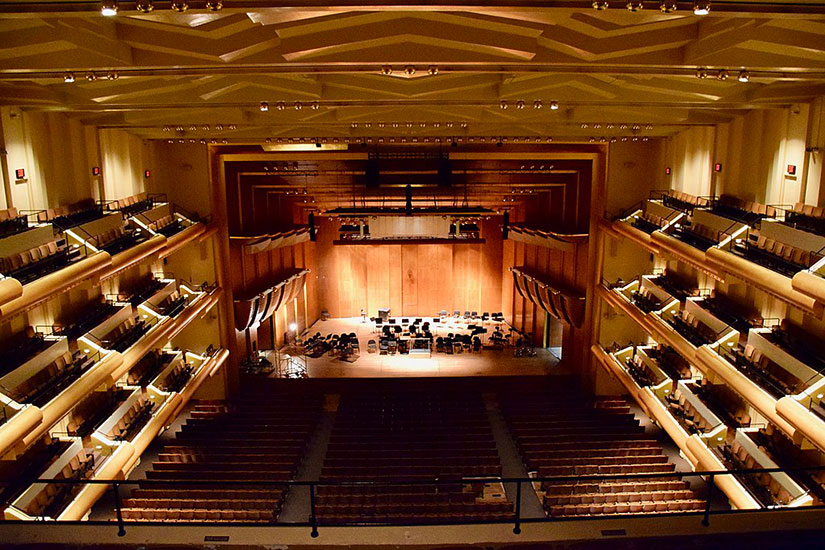Lincoln Center’s Geffen Hall to Get Long-Awaited Revamp

The renovation will transform the hall’s boxy interior with curvilinear blond wood surfaces.
Image courtesy Lincoln Center

The exterior of the building will be virtually untouched except for features intended to enhance connections to the city, including a light frieze that will wrap around the facade’s upper perimeter.
Image courtesy Lincoln Center.

The new plan is the latest in a series of proposals meant to address long-criticized acoustics, lack of intimacy, and drab interior ambiance of the existing hall (shown).
Photo © Wikimedia user Tjbickerton

From left to right: Henry Timms (Lincoln Center), Deborah Borda (New York Philharmonic), Paul Scarborough (Akustiks), Billie Tsien (Tod Williams Billie Tsien Architects), Gary McCluskie (Diamond Schmitt), Joshua Dachs (Fisher Dachs), Tod Williams (Tod Williams Billie Tsien Architects)
Photo © Architectural Record




On Monday, Lincoln Center officials revealed a new $550 million plan to remake the New York Philharmonic’s home, David Geffen Hall. The revamp, with Toronto-based Diamond Schmitt Architects focusing on the performance space and the New York firm Tod Williams Billie Tsien Architects designing the public areas, will leave the stately but modern exterior of the 1962 Max Abramovitz–designed building virtually untouched. It is the latest in a series of proposals meant to address the hall’s long-criticized acoustics, lack of intimacy, and its drab interior ambiance. Among these earlier efforts was a 2015 scheme by Diamond Schmitt and London’s Heatherwick Studio, chosen after an invited competition but then abandoned two years ago.
Diamond Schmitt, whose performing arts spaces include the new Mariinsky Theater, in St. Petersburg will transform Geffen’s boxy interior with curvilinear blond wood surfaces to create what principal Gary McCluskie describes as a hybrid of vineyard and shoebox concert hall types: The proscenium will be eliminated, the number of seats reduced from 2,700 to 2,200, and the stage will be moved forward 25 feet with balconies wrapping around it. These moves will enhance the space’s resonance and bring most of the audience within 100 feet of the performers—close enough to see the faces of the orchestra members and observe the interaction among them, according to Paul Scarborough, a principal at Akustiks, the project’s acoustician. (Other consultants include Fisher Dachs, a theater planning and design firm.)
The building (known as Avery Fisher Hall until 2015, when the entertainment mogul David Geffen made a $100 million gift) will also be outfitted with technology that will enhance its flexibility. These include systems for livestreaming performances and infrastructure that will allow easy reconfiguration of the stage to accommodate an orchestra, solo performances, and films.
The public spaces are being reimagined with more places to sit and multiple dining and drinking spots. The goal is for these areas to exude “generosity and warmth”—encouraging people to arrive early for performances and linger afterwards, says Tsien. The lobby, which is to include a media wall for streaming concerts and other events in real time, would be open to all—even those who don’t have a ticket, she says.
Deborah Borda, the Philharmonic’s president and CEO, who held the same post at the Los Angeles Philharmonic, where she oversaw the completion of Frank Gehry’s Walt Disney Concert Hall, describes the new design for Geffen as “pragmatic” and “rigorously planned.” Though its price tag is more than the official $500 million budget for the makeover announced in 2015, reports estimated that the earlier, more elaborate scheme would cost much more. Another major concern was that construction could keep the Philharmonic out of its home for several seasons. But under the current plan the hall will close for two periods: first in May 2022, slightly earlier than the end of its regular season, reopening in October; and then closing again in May 2023, reopening for good in March of the next year. During the second closure period, the Philharmonic will perform at other New York venues, including Carnegie Hall. The shortened, phased construction schedule will be made possible in large part by prefabrication, according to McCluskie. Balcony fronts and other components will be assembled off-site in a process he compares to a “giant Lego farm.”
The project is moving forward with about two thirds, or $360 million, of the construction budget already raised. Henry Timms, Lincoln Center’s president and CEO, is hopeful that some of the remaining funds will come from the city. “We are engaging city officials to talk to them about the many benefits that this will have for New Yorkers of all backgrounds and for people traveling from around the world.”








